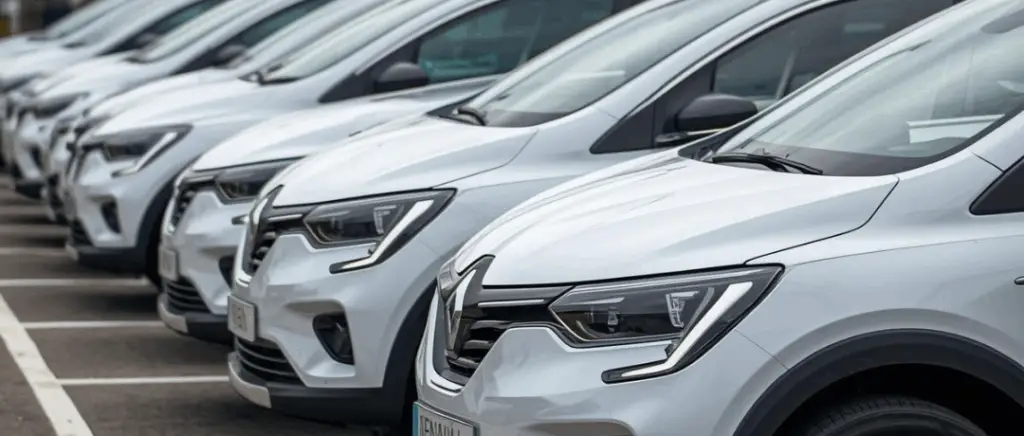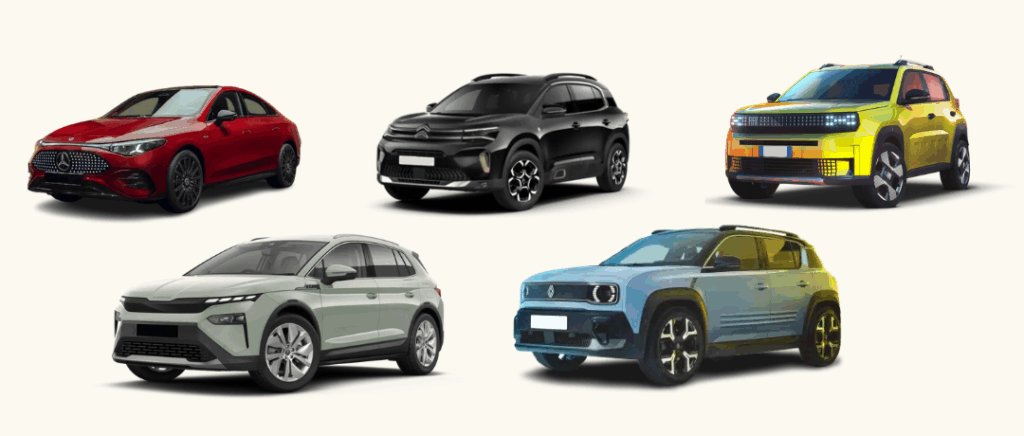Why is Europe betting on electric vehicles to meet its climate targets?
Europe is betting on electric vehicles because they are now the central tool for massively reducing emissions from the automotive sector, one of the most polluting on the continent. By setting the target of banning the sale of new combustion-powered vehicles by 2035, the European Union aims to accelerate the energy transition and achieve carbon neutrality by 2050.
Several factors explain this strategic choice:
- Direct reduction in CO₂ emissions: an electric vehicle emits on average 2 to 3 times less CO₂ over its entire life cycle than a combustion engine, especially with electricity becoming increasingly decarbonised in Europe.
- Support for renewable energy : The development of electric mobility is based on an energy mix in which solar, wind and hydroelectric power are playing an increasingly important role, reinforcing ecological coherence.
- Energy independence : By limiting its dependence on imported oil, Europe is gaining in sovereignty and securing its future in the face of geopolitical tensions linked to fossil fuels.
- Innovation and industrial competitiveness : Investing in the electrical sector will help create an ecosystem around batteries, electrical equipment charging stations and new automotive technologies, giving Europe an edge in the global race for sustainable mobility.
- Improving air quality : By reducing fine particles and nitrogen oxides in cities, the mass deployment of electric cars will have a positive impact on public health and the well-being of citizens.
By placing electric vehicles at the heart of its climate strategy, the European Union is not just imposing ambitious regulations: it is shaping the future of the automotive market and guiding its players towards sustainable, competitive and socially beneficial mobility.
What concrete benefits do electric cars bring to consumers and industry?
Electric cars are not just a response to the environmental constraints set by the European Union for 2035: they are already offering tangible benefits, both for motorists and for the automotive industry as a whole.
Their widespread adoption is part of a drive for energy efficiency, cost reduction and industrial competitiveness.
For consumers:
- Reduced running costs : the price per kilometre of an electric car is still much lower than that of combustion engines, thanks to cheaper energy and lower maintenance costs.
- Comfort and driving experience : Engine silence, instant acceleration and innovations linked to connected systems enhance everyday driving pleasure.
- Access to tax incentives : Purchase incentives, environmental bonuses, exemptions from certain taxes and preferential parking rates make electric cars more attractive financially.
For industry :
- Accelerating innovation : The switch to electric vehicles is stimulating research into batteries, on-board software and autonomous technologies, boosting the competitiveness of European carmakers.
- New market opportunities : electrification opens the way to new services (charging stations, shared mobility solutions, grid-energy integration).
- Contributing to Europe's energy transition : By reducing its dependence on oil, the automotive industry is aligning itself with the objectives of carbon neutrality and supporting the continent's energy sovereignty.
This alignment between individual and collective benefits illustrates why the electric vehicle is much more than an alternative: it is the central pillar of Europe's automotive future.
How is the European market moving towards mass adoption of electric vehicles?
The European automotive market is undergoing an unprecedented transformation, driven by strong political decisions and growing demand for sustainable mobility. The 2035 target, which calls for an end to the sale of new combustion-powered vehicles, is acting as a powerful accelerator towards the electrification of private and business fleets. This dynamic is expressed at several levels:
- Structuring public policies : The European Union is imposing strict standards for reducing CO₂ emissions, while many countries are stepping up their ecological bonus schemes, conversion bonuses and tax exemptions for electric vehicles.
- Massive investment in infrastructure: The rollout of fast-charging stations is intensifying along strategic roads and in urban areas, facilitating daily use and long-distance travel.
- A wide range of vehicles: European and international manufacturers are increasing the number of models (from the electric city car compact Electric SUV ) to meet the different needs of consumers and businesses.
- Gradual reduction in battery : the industrialisation of gigafactories and technological innovation are reducing the price per kWh, making electric vehicles more accessible.
- Increasing adoption by professional fleets : companies and local authorities are massively integrating electric vehicles into their mobility plans in order to reduce their running costs and their environmental impact. carbon footprint.
In this way, Europe is positioning itself as a pioneering laboratory for electric mobility, where a combination of financial incentives, technological advances and political will is paving the way for rapid mass adoption of zero-emission vehicles.
What initiatives is the European Union taking to support the transition to electric vehicles?
The European Union is implementing a series of ambitious and complementary initiatives to support the transition to electric vehicles, in line with its objective of ending sales of combustion-powered vehicles by 2035.
These structuring actions cover regulation, infrastructure and industrial and economic support:
- Tougher CO2 emission standards: The European regulation sets a gradual reduction in average emissions from new vehicles, with a clear trajectory towards 0% of emissions by 2035. This restrictive framework obliges manufacturers to speed up the production of electric and rechargeable hybrid vehicles.
- Mass deployment of recharging infrastructure : Through the AFIR regulation and the EPBD directive on the energy performance of buildings, the EU is imposing national plans on Member States to create a dense and accessible network of public and private charging stations, particularly in urban areas and condominiums.
- Industrial support and local investment : The European Green Pact includes an industrial plan to strengthen the production of batteries, vehicles and clean technologies in Europe, thereby promoting innovation and industrial sovereignty while creating sustainable jobs.
- Simplification of procedures and administrative harmonisation : The EU is working to reduce the time and complexity of electrical connections and to harmonise national regulations, thereby facilitating the rapid development of recharging infrastructures.
- Economic incentives and investment plans : European and national subsidies complement these measures, aimed at stimulating demand for electric vehicles and providing financial support for the ramp-up of local industrial capacity.
These joint initiatives are creating a robust ecosystem, which is essential if we are to make a success of the energy transition in the European automotive sector and achieve the essential target set for 2035.
Is the 2035 timetable still realistic, given the technological advances in electric vehicles?
The 2035 timetable, which marks the end of sales of new combustion-powered vehicles in Europe, depends largely on the ability of electric vehicles to meet consumer expectations and climate requirements. Thanks to recent innovations, several signals confirm the feasibility of this objective:
- Improving theautonomy : the latest generation of batteries (lithium-iron-phosphate, solid or ultra-fast-charging) can achieve ranges in excess of 500 km WLTP, reducing distance-related anxiety.
- Increased recharge speed : High-power recharging networks are being rolled out rapidly, making it possible to recover 80% of battery in less than 20 minutes, a time comparable to a coffee break on the motorway.
- Gradual reduction in costs : the reduction in the price of batteries is making electric vehicles more accessible and accelerating their take-up by the general public and business fleets alike.
- European industrial innovation : With projects such as the development of local batteries (French and German Gigafactories) and platforms dedicated to electric SUVs and city cars, Europe is strengthening its technological independence.
- Integration with renewable energies : the widespread use of vehicle-to-grid and smart charging enables electric cars to become part of a sustainable and flexible ecosystem, which is essential for the energy transition.
Make your energy transition now, with a range of new 100 % electric vehicles available for leasing from Beev!
How can Europe boost its competitiveness against China through electrification?
Europe faces formidable competition from China, which already dominates the battery value chain and offers electric vehicles at often unbeatable prices. To maintain its ambitions in terms of climate change and its 2035 target, the European Union must not only accelerate electrification but also strengthen its industrial and technological sovereignty.
A number of levers are essential:
- Invest massively in local battery production: thanks to the development of gigafactories The EU can reduce its dependence on Chinese imports and secure its strategic supplies.
- Stimulating innovation and R&D : European carmakers need to step up investment in new battery chemistries (lithium-iron-phosphate, solids) and in the energy efficiency of electric motors to remain competitive with Asian brands.
- Implementing a balanced commercial policy : by protecting its market through targeted customs duties on low-cost imported vehicles, while supporting strategic partnerships with international players.
- Speeding up the roll-out of recharging infrastructure : Having a dense and reliable network on a European scale is a major asset in convincing consumers and supporting the growth of the electricity market.
- Strengthen financial and tax support : via incentives for local production, support for demand and aid for the conversion of industrial sites.
What positive impact will the electricity transition have on employment and the European economy?
The transition to electric vehicles, supported by the 2035 target for the end of new combustion engines, represents a strategic lever for the European economy. As well as reducing emissions, it opens up new prospects for innovation, growth and job creation in a wide range of sectors.
Positive impact on employment and the European economy :
- Creating skilled jobs : The rise of electromobility is boosting demand for engineers, technicians and specialists in batteries, on-board software and recharging systems.
- Industrial relocation : the establishment of gigafactories and factories dedicated to electrical components promotes European sovereignty and reduces dependence on imports from outside Europe.
- Growth in the recharging infrastructure sector : The massive roll-out of electric charging points across Europe is generating business in construction, maintenance and energy services.
- Attracting foreign investment : European policies in favour of electric vehicles are making the European market more attractive to manufacturers and start-ups specialising in clean technologies.
- Boosting local ecosystems : New industries are emerging around battery recycling, energy recovery and the circular economy, offering sustainable jobs that cannot be relocated.
By placing the electric vehicle at the heart of its industrial strategy, the European Union is betting on a transformation that combines competitiveness, innovation and long-term economic resilience.
Why is the electric car now the most credible solution for reducing CO₂ emissions?
The electric car is now emerging as the most solid option for supporting the energy transition in the automotive sector. In view of the climate commitments made by the European Union, it offers a concrete and measurable response to reduce CO₂ emissions, both on an individual and collective scale.
There are a number of arguments to support its credibility:
- Zero tailpipe emissions: Unlike combustion-powered vehicles, electric cars emit no CO₂ or polluting particles when on the road, reducing the carbon footprint in urban areas.
- A constantly decarbonising energy mix : In the EU, an increasing proportion of electricity comes from renewable sources, which further reduces the overall emissions of an electric vehicle over its life cycle.
- Superior energy efficiency : On average, an electric motor converts more than 70% of the energy consumed into motion, compared with only 30% to 40% for a combustion engine, limiting losses and maximising fuel efficiency.
- Potential for grid integration : through intelligent recharging technologies and vehicle-to-gridElectric cars help to stabilise the electricity system and make the most of surplus renewable energy.
- Progressive reduction in battery footprint : Thanks to recycling and innovations (solid batteries, reduction of critical metals), the environmental impact of production is reduced, reinforcing the ecological viability of this type of vehicle.
What challenges remain to ensure a secure, high-performance electricity future for Europe?
Despite the 2035 target for the end of sales of new combustion-powered vehicles being maintained, a number of major obstacles still need to be overcome to ensure a smooth and sustainable transition to electromobility. These challenges concern infrastructure, the supply chain and European industrial competitiveness.
- Deployment of charging stations : ensure uniform coverage throughout Europe, including in rural and peri-urban areas, to avoid inequalities in access to electric mobility.
- Power grid capacity : adapting energy infrastructures to the growing needs generated by millions of connected electric vehicles, while integrating more renewable energies.
- Industrial sovereignty and batteries : Reduce dependence on imports of critical raw materials (lithium), cobalt, nickel) and develop a competitive and sustainable European battery manufacturing industry.
- Cost of vehicles : make electric cars more affordable by working to bring prices down through economies of scale, technological innovation and new financing solutions.
- Recycling and the circular economy : setting up efficient second life and recycling processes for batteries to limit their environmental impact and secure supplies of strategic materials.
- Social acceptance and training : support the general public, as well as professionals in the automotive industry, through awareness-raising campaigns and appropriate training schemes.
Conclusion
The 2035 target is much more than just a regulatory deadline: it represents a historic transformation for the European automotive industry and for the future of sustainable mobility. By placing the electric vehicle at the heart of its strategy, the European Union is seeking to combine a reduction in emissions, energy independence and industrial competitiveness in the face of increased global competition.
While the environmental, economic and societal benefits are already tangible, the success of this transition will nevertheless depend on the ability of European players to meet the remaining challenges: mass deployment of infrastructure, lower costs, sovereignty over batteries and public involvement.
So the electrification of Europe's car fleet not only marks the end of the internal combustion engine, but also the start of a new era in which innovation, energy efficiency and sustainable performance are shaping the future of mobility on the continent.
You would like toto electric?
Beev offers multi-brand 100% electric vehicles at the best prices, as well as recharging solutions.
































